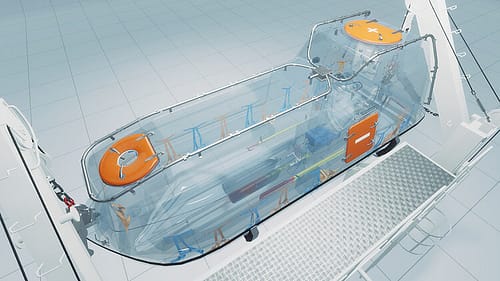This cost-effective training solution is based on Virtual Reality (VR) technology which means that you get low hardware cost and high mobility. In other words – training anywhere, anytime, even on board a vessel. This product has been tested by many of the leading safety training operators in Norway and the feedback we are getting is amazing!
Familiarization Mode
In the familiarization mode the training candidates get an in-depth understanding of the construction and functionality of the lifeboat and davit system. When “X-ray” mode is toggled, the user can view internal equipment and structures which is normally hidden or difficult to view. This gives a greater and more comprehensive understanding of how the equipment is constructed and functions.
The familiarization mode is a clinical environment and this also makes it comfortable for the user to get used to interaction and navigation in VR before entering full mission scenario.
All equipment is fully functional and can be operated in familiarization mode, both lifeboat and davit.
Scenario Mode
When familiarization mode is completed, the user is ready for full mission scenario training. Here the training candidates work together to execute the following steps:
- Prepare lifeboat and davit for launch
- Lower lifeboat to embarkation position
- Complete embarkation procedure
- Release painters
- Turn on lifeboat battery
- Start lifeboat engine
- Lower lifeboat to ocean surface
- Release hooks
- Release skates
- Manouver lifeboat to clear ship
- Return lifeboat to ship
- Attach hooks
- Raise lifeboat
- Fasten painters
- Lock davit
- Lower lifeboat to ocean surface
In scenario mode the participants see avatars of each other and use voice communication. They can also communicate with the instructor. It is also possible for the instructor to be a participant in the scenario (this is also possible in familiarization mode).
Bridge Module
With this option, you get a fully operational VR bridge simulator for the mother vessel in the scenario. This makes the training scenario even more realistic with coordination between the bridge and lifeboat crew. You can add even more modules to expand the training scenario further.
This definitely takes lifeboat training to the next level.
Compliance
IMO has accepted that simulators may be used to replace the infrastructure of a usual ‘hands-on’ approach, with students undertaking theoretical classes, accompanied by contact with a real lifeboat, davits and equipment, so long as trainees can continue to demonstrate accomplishment of the competences detailed in STCW tables referring to this training.
Survival craft competences of STCW are described in tables A-VI/2 -1 and the requirements of the course in part A of the same convention. STCW 2010 (Manila Amandments) requires re-certification for all mariners every five years.
The training also refers to SOLAS and LSA Code requirements for Safety of Life and equipment characteristics requirements.
The Norwegian Maritime Authorities have now approved the use of VR simulators in lifeboat training, in accordance with the guidelines stated above.
Lifeboat Scenario is:

Cost Effective
Both in acquisition and operation (hardware: only laptop and VR headset).
Scalable
Add twin simulators at low cost for more complex scenarios and/or parallel training.
Portable
Train anywhere and anytime; Train on site, off-site or even on board vessel.
Multi-User
Collaborate in the same scenario, from the same or different locations.
High Training Volume
Simulator allows trainees to repeat training without increased cost.
Safety
No risk of harm or damage to personnel or equipment.
Instructor Station
The tablet application gives the instructor full control of the training session. He can also communicate wirelessly with training candidates using the tablets microphone and speaker.
Functionality overview:
- Time of day
- Wind direction & speed
- Rain
- Alarms
- Multi-user role/position assignment

- Ocean wave spectrum
- Visibility (fog)
- Mother vessel positioning
- Failure modes
- Wireless voice communication w/ participants
Instructor Station Features:

Plans & Pricing
Our subscription plans are designed to reduce risk in acquisition of training simulators and to scale and follow your business model.
At the bottom of this page you find a link to more information about subscription plans and pricing.
PORTABLE SETUP – fits in a laptop backpack!








